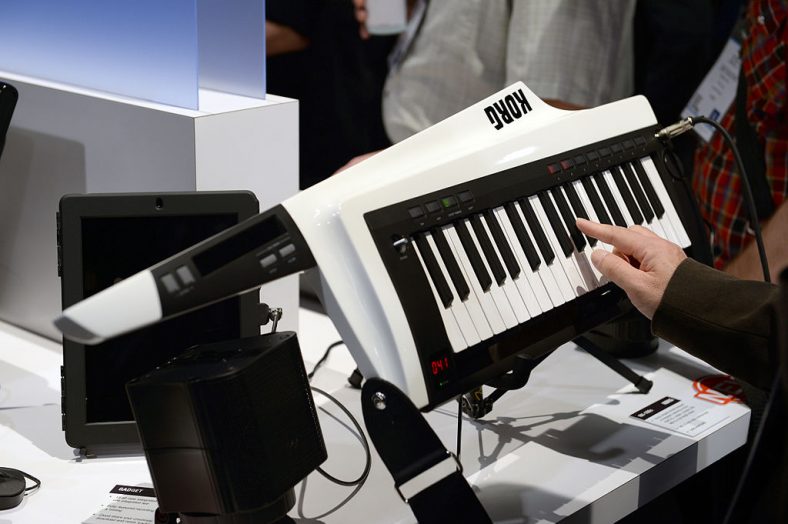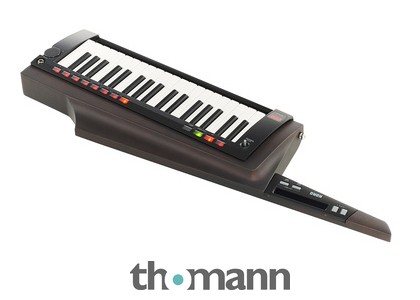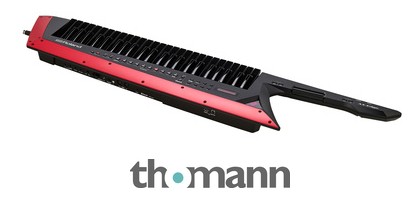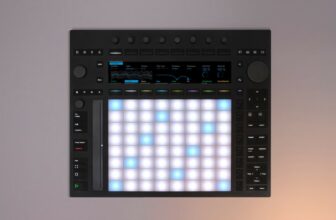The 6 Best Keytars (2024) – Synths and MIDI Controllers

A keytar is that cool little lightweight synthesizer you see that is help like a guitar and almost played like one. They were highly used by famous musicians in the disco era and much to anyone’s surprise, they still are!
Are you looking to start rocking a keytar? You wouldn’t be the only one! Matt Bellamy (Muse), Damon Albarn (Gorillaz), and Jazz legend Herbie Hancock are just a few that have performed with them. Whether you’re looking for a fully self-contained instrument or a MIDI keytar, you’ve come to the right place because today we’ll look at the 6 best Keytars on the market.
My top recommended keytar is the Alesis Vortex Wireless 2. An impressively well-rounded instrument at an affordable price. It’s a great overall keytar that is used by many.
My second recommended keytar is the Yamaha Sonogenic Keytar. For those looking for a more budget-friendly option, this lightweight keytar is affordable yet decent in quality.
Contents
- The 6 Best Keytars of (2024)
- 1. Alesis Vortex Wireless 2
- 2. Yamaha Sonogenic Keytar
- 3. Korg RK-100S Keytar with MMT Black
- 4. Yamaha Vocaloid
- 5. Behringer Analog Synthesizer
- 6. Roland AX-Edge Keytar
- Are Keytars Easy to Play?
- Are Keytars Heavy?
- What do People Think of Keytars?
- What to look for in a Keytar when Buying?
- Conclusion
The 6 Best Keytars of (2024)
Let’s compare these in more detail.
1. Alesis Vortex Wireless 2
Starting off this list is an affordable and very well-rounded keytar. Alesis Vortex Wireless 2 is a MIDI-controller keytar that comes with a bunch of options and is great for the studio environment.
Since it’s a MIDI controller, this keytar can’t produce sound by itself, but needs to be connected to the computer or other external gear. This is a 37-key keytar, which comes with 8 RGB backlighted programable pads and 8 programable sliders, usually used for the EQ.
On the neck, you’ll find a wheel for pitch bending and a volume slider, as well as touch strip, zone, sustain, and octave-control buttons that you can control easily. It also has an accelerometer which can be used for bends as well.
The keys on this keytar are velocity-sensitive with aftertouch, giving you all the feel, you might need when you’re playing this thing. Vortex Wireless 2 works on USB power or 4 AA batteries, giving you full range and mobility when playing.
As for the connectivity, the USB Bluetooth dongle that you get together with the keytar will provide a quality, stable wireless connection.
All in all, this is an affordable option, a lower-end MIDI controller that will provide you with a lot of options and give you a workstation feeling for only a fraction of the money you would need for a full keytar.
This more compact keytar comes with standard 37 keys. You should note that the keys are a bit smaller than standard so if you’re accustomed to standard keyboards, you might need some adjusting to do.
It has MIDI I/O so you can use it as a MIDI controller, USB connection, Bluetooth, and standard ¼” and 3.5mm MIDI jacks.
The great thing about this keytar is that it has its speakers so that you can play it without any other equipment, or you can jack it straight to the amplifier if need be. What separates this keytar from others is the Jam option.
The Jam is Yamaha’s way of letting anyone play songs the same as if they knew how to play them. You need to hit keys at the right time, and the preset sounds will play the song. It’s a great feature if you want to relax and have some fun with your friends, even though they don’t know how to play.
This is an excellent learning keytar since it’s smaller in size compared to the other keytars out there. However, it still offers a lot of different options that you need for serious playing.
3. Korg RK-100S Keytar with MMT Black
Korg RK-100 was one of the first keytars to be mass-produced in the 1980s and has become an iconic instrument in the history of pop music. 35 years later, Korg decided to put out the upgraded and modernized version of the original.
RK-100S is a beautiful keytar with 37 keys. Even though they are a bit smaller than standard keys to help bring the weight and size of the instrument down, you should have no problems playing them.
The body of this instrument is solid wood, and you can choose from three finishes. As far as the connectivity goes, you have MIDI out, a microphone jack, and a ¼” jack, as well as the power connection. It has built-in speakers.
Sound is the main reason why this keytar was so popular back in the day. Today, you can find 200 preset sounds on the sound module, which you can alter through your computer when you connect the instrument.
It comes with two control strips – one on the neck and the other beneath the keys. With these strips, you can control and use a bunch of different options, which gives you full control over the instrument anyone might need.
Also, it comes with 8 programable buttons like the octave buttons, and several different ones to control all of the effects.
All in all, this is a great, professional keytar, that justifies its reputation. It’s a quality product that you can use both in the studio settings and on the road, and that will last you for a long time, whether you’re a beginner or a professional.
4. Yamaha Vocaloid
It’s a singing-synth keytar, which is very popular in Japan, and particularly popular for Anime soundtracks. However, it could be used creatively in many electronic music genres.
The Yamaha Vocaloid VKB-100 is similar in build to the previously mentioned Sonogenic keytar, with 37 keys and pretty basic connectivity options. Its main feature is its Vocaloid function. It has a large bank of internal vocal presets which you can play and tweak effects.
You can also play this in normal keyboard mode, which sounds great. This is more of a niche item, but it’s pretty cool!
5. Behringer Analog Synthesizer
The Behringer Analog Synth is a very sturdy and crisp-looking keytar. It’s essentially a regular synthesizer but it comes with a handle and a strap, thus making it a keytar.
This moderately priced synth has 32 semi-weighted full-size keys that offer good sensitivity while playing, with a realistic and good-quality sound with an oscillator that allows for mixable sound waves.
This particular Behringer model is praised and frequently used for live performances, with a fairly easy weight and medium-size keyboard, it’s easy to carry around and play. Plus, it offers some really handy extra features that make sound shaping and quality even more impressive.
The perfect sweet spot when it comes to modern-day keytars. The Behringer Analog Synthesizer is one to consider if you’re looking for the perfect mid-range product.
6. Roland AX-Edge Keytar
The Roland AX-Edge is an absolute beast of a keytar! This 49-key Roland keytar is fully equipped with full-sized, velocity-sensitive keys that offer great playability. As far as versatility is concerned, this one is probably the most versatile of all on the list.
It features 320 programs and over 500 presets that include effects like reverb, chorus, delay, even a compressor and EQ which are a must! This multi-effect keytar has it all, not to mention the aesthetically pleasing look that drops jaws. One other thing to note is the exceptional internal sounds that this piece possesses.
The AX-Edge can be powered by an AC adapter or via battery which lasts up to 4 hours. Considering the value of this product, that’s not bad, you can get through an entire gig without worrying about your battery life.
If you want a stunning keytar that offers an abundance of programs and effects, I doubt that you will find a better one out there, as this model is one of the best.
Are Keytars Easy to Play?
Yes, they are easy to play. It’s just a keyboard that’s hanging around your shoulders with some extra controls to alter the sound. Regarding skill, it’s the same as a keyboard or piano – meaning that it takes a lot of time to get the hang of.
To truly master an instrument like this, you’re looking at years of practice as the piano in general is one of the hardest instruments in the world to master.
Are Keytars Heavy?
Early synths were heavy and bulky. Advancements in technology have made them very light and easy to carry around. Now, you can find keytars that weigh a total of 1 pound which is insane considering the sonic capabilities of these instruments.
What do People Think of Keytars?
Keytars finally allowed keyboard players to become a part of the band on stage, not just sitting behind their keyboards all the time.
They were initially sneered at when they first appeared on the scene. Though over the years, people realized keytars can be pretty cool instruments.
What to look for in a Keytar when Buying?
First and foremost, key size and effects should be the top priority. Key-size around 32 to 49 is optimal for a good base and sonic possibilities. As far as sound effects are concerned, a multi-effects keytar will add much more quality and variety to your sound.
Reverb, delay, chorus, compression, EQ, and many more of these are crucial elements to a good-sounding keytar. Weight shouldn’t be an issue, however, key weight should be. Semi-weighted and Synth-action are two different things. You also have velocity-sensitive keys to look out for.
Secondly, the quality of the products should always be important. Good and quality brands like Behringer, Roland, and others provide and manufacture great quality and durable instruments. Keep an eye out for velocity-sensitive trigger pads, and velocity-sensitive drum pads as they are top-notch components.
This also doesn’t mean that only those brands and models should be considered, Yamaha is great in the keytar department as well and offers more affordable yet decent quality keytars. Compatibility is another thing to keep in mind, like Bluetooth MIDI options. Check to see if the keytar is PC, MAC, or even laptop compatible.
Lastly, consider the price. If you’re a beginner and you want something good to start with, check the affordable options above and give them a try first before moving on to the more pro options. As I mentioned, these things take time to master, so a decent quality keytar will do just fine for a year or two.
There is no need to go overboard with expenses if you’re just starting, however, if you’re a more seasoned player then you should consider the more high-end options for a more quality and versatile sound. As a general rule, all instrumentalist upgrade their gear from time to time.
Conclusion
Keytars are a great way to add an extra performance element to keys on stage. As you can see from the options above, there are plenty of features on these instruments to get creative. The sonic capabilities of these instruments are simply off the charts!
My top keytar pick is the Alesis Vortex Wireless 2. A very well-rounded yet affordable keytar and great quality too.
My budget keytar pick is the Yamaha Sonogenic Keytar. If you want a budget-friendly keytar that also has great and quality components, then this one will do the trick.
Featured Image: By Brandon Daniel from USA / CC BY-SA











